This
page describes Ray Carney's discovery of a new long print of Faces.
To read about Ray Carney's discovery of the long-lost first version
of Shadows, click
here.
The
first version of Shadows and the long version of Faces
are two of Ray Carney's most important artistic finds, but Professor Carney
has made a name for himself as the discoverer and presenter of many other
new and unknown works of art. To read about a few of his other cinematic
and literary finds, click
here.
To read about other unknown Cassavetes material (including recording studio master tapes and an unknown film by Cassavetes) Ray Carney has discovered, click here.
To
read a chronological listing of events between 1979 and the present connected
with Ray Carney's search for, discovery of, and presentation of new material
by or about John Cassavetes, including a chronological listing of the
attempts of Gena Rowlands's and Al Ruban's to deny or suppress Prof. Carney's
finds, click
here.
Click
here for best printing of text
December
10, 2001
PRESS RELEASE
For immediate release
Lost
and Found Department
A Previously Unknown Version of John Cassavetes's Independent Masterwork Faces
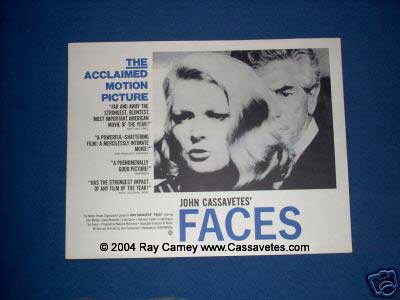 Maverick
actor-writer-director John Cassavetes has been called the spiritual
father of American independent filmmaking. Because he made most
of his movies outside the studio system and financed them himself
(paid for with his salary as an actor in other directors' films),
he was free from the normal constraints that limit most American
filmmakers. He could make movies about anything he wanted. He
could take as long as he wanted to shoot them. And he could spend
as much time as he needed to edit them—changing his mind
as he went along. At least when it involved his non-studio work,
Cassavetes made films the way poets write or painters paint.
There were no commercial deadlines or bureaucratic compromises.
The film wasn't finished until he was finished with it. Maverick
actor-writer-director John Cassavetes has been called the spiritual
father of American independent filmmaking. Because he made most
of his movies outside the studio system and financed them himself
(paid for with his salary as an actor in other directors' films),
he was free from the normal constraints that limit most American
filmmakers. He could make movies about anything he wanted. He
could take as long as he wanted to shoot them. And he could spend
as much time as he needed to edit them—changing his mind
as he went along. At least when it involved his non-studio work,
Cassavetes made films the way poets write or painters paint.
There were no commercial deadlines or bureaucratic compromises.
The film wasn't finished until he was finished with it.
Cassavetes's home movie/feature
film, Faces, is a case in point. When it was released
in 1968, it was not only heralded as a turning point in the independent
movement—the first time a noncommercial movie had been embraced
by a mass American audience; but it was celebrated as one of
the major works of American film art. Renata Adler's pronouncement
in The New York Times can stand for all. She called Faces: "Far
and away the strongest, bluntest, most important American movie
of the year ... a motion picture so good one can hardly believe
it." Notwithstanding the non-Hollywood nature of the production, Faces went
on to garner three Academy Award nominations.
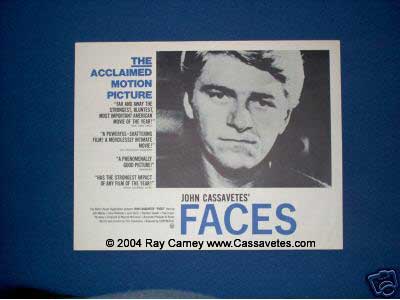 The
movie had been created in an entirely different way from a Hollywood
feature. It had been filmed in Cassavetes's home. The actors
had worked for nothing. Cassavetes had lavished six months on
the shooting process (as opposed to the six or eight weeks Hollywood
would have devoted to a comparable low-budget film), shooting
an unprecedented hundred and fifteen hours of footage. He had
then spent more than two years tinkering with the edit—in
the final six months, screening different assemblies to see how
audiences reacted to different edits. The
movie had been created in an entirely different way from a Hollywood
feature. It had been filmed in Cassavetes's home. The actors
had worked for nothing. Cassavetes had lavished six months on
the shooting process (as opposed to the six or eight weeks Hollywood
would have devoted to a comparable low-budget film), shooting
an unprecedented hundred and fifteen hours of footage. He had
then spent more than two years tinkering with the edit—in
the final six months, screening different assemblies to see how
audiences reacted to different edits.
Faces went through
five or six completely different assemblies, with different scenes,
different shot selections within scenes, different mood music,
and different running times for each version. For the past thirty-four
years, the conventional wisdom has been that Cassavetes destroyed
all of the alternative assemblies at the point he settled on
the final release print.
Enter Ray Carney, Professor
of Film and American Studies at Boston University, who is generally
regarded as the world's authority on Cassavetes's life and work.
He maintains a web site devoted to the filmmaker, and has published
many books on him. The most recent is the monumental 550-page Cassavetes
on Cassavetes, based on 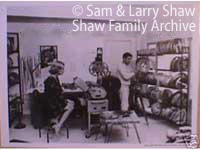 conversations
with Cassavetes in the final decade of his life. Roger Ebert
praised it as "a labor of love, scholarship, and detective
work. From a chaotic mountain of primary and secondary sources,
Ray Carney has shaped the story of John Cassavetes' life and
work—using the words of the great director himself, and
also calling on his colleagues and friends to supply their memories
and revelations. 'This is the autobiography he never lived to
write,' Carney says, but it is more: Not only the life story,
but history, criticism, homage, lore. Like a Cassavetes film,
it bursts with life and humor, and then reveals fundamental truths." conversations
with Cassavetes in the final decade of his life. Roger Ebert
praised it as "a labor of love, scholarship, and detective
work. From a chaotic mountain of primary and secondary sources,
Ray Carney has shaped the story of John Cassavetes' life and
work—using the words of the great director himself, and
also calling on his colleagues and friends to supply their memories
and revelations. 'This is the autobiography he never lived to
write,' Carney says, but it is more: Not only the life story,
but history, criticism, homage, lore. Like a Cassavetes film,
it bursts with life and humor, and then reveals fundamental truths."
In late summer, Carney
was paging through the Library of Congress's on-line catalogue
and noticed an unexplained discrepancy. The Library owned several
prints of Faces, but one of 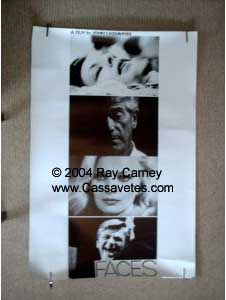 them
was catalogued as having the wrong length. Each of the entries
for the film should have read approximately the same length—around
11,600 feet (129 minutes); but one clocked in at 13,110 feet
(147 minutes). When Carney contacted staff members at the Motion
Picture Division of the Library of Congress, he was told it was
probably just a clerical error. But he said he felt in his bones
that it just might be one of the "lost" alternate edits
of the film. them
was catalogued as having the wrong length. Each of the entries
for the film should have read approximately the same length—around
11,600 feet (129 minutes); but one clocked in at 13,110 feet
(147 minutes). When Carney contacted staff members at the Motion
Picture Division of the Library of Congress, he was told it was
probably just a clerical error. But he said he felt in his bones
that it just might be one of the "lost" alternate edits
of the film.
"I was busy with
lectures and speaking engagements nearly every week of the fall;
but in late October and early November, after four days at the
Virginia Film Festival and a series of visiting lectures at Hollins
University, I squeezed in a side trip to the Library of Congress—to
see for myself. When I put the print on the Steenbeck, I realized
within seconds that I was not looking at a cataloguer's error."
Carney, who says he
knows the film shot-by-shot by heart, said the tip-off was not
only that the print began with a long credit crawl that is not
in the released version (which holds its credits until the end),
but that, even more interestingly, the credits in this print
included names of actors whose scenes are not in the release
print as well as titles of musical pieces not in the final film. "The
evidence from the credits alone was so conclusive, and I was
so excited, that I stopped the film before the first scene had
appeared on screen and told staff members what they had had sitting
in storage unknown to them for so many years, waiting to be discovered."
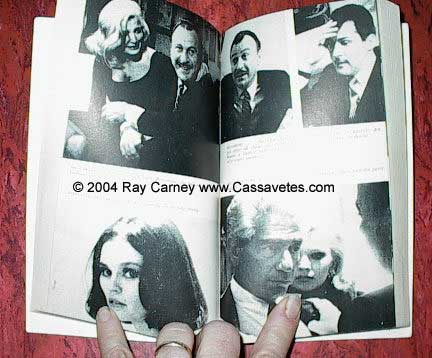 Carney
says that the print has many differences from the release version. "The
Library of Congress print has 18 minutes of entirely new footage
at the start—different scenes, characters, and events that
are not in the release print. That additional material accounts
for the longer running time. But the differences don't end there.
Each of the major scenes is presented in a slightly different
assembly from the release version, with slightly different shots
and different lines of dialogue at various points. The most striking
additional difference (beyond the different beginning scenes)
is in a long scene in the middle of the movie (the McCarthy and
Jeannie scene for those who know the film). Carney
says that the print has many differences from the release version. "The
Library of Congress print has 18 minutes of entirely new footage
at the start—different scenes, characters, and events that
are not in the release print. That additional material accounts
for the longer running time. But the differences don't end there.
Each of the major scenes is presented in a slightly different
assembly from the release version, with slightly different shots
and different lines of dialogue at various points. The most striking
additional difference (beyond the different beginning scenes)
is in a long scene in the middle of the movie (the McCarthy and
Jeannie scene for those who know the film).
"Since the Library
of Congress print is not in a rough or unfinished state, as the
presence of a finished credits sequence—one of the last
things to be added to a movie—indicates, it seems likely
that it represents one of Cassavetes's final versions; in fact,
it may have been intended to be the release version."
Carney summarizes the
artistic importance of the discovery: "Faces is one
of the seminal masterworks of American independent film. It is
to the American independent movement what The Passion of Joan
of Arc is to silent film or The Rules of the Game is
to French cinema. It's an historical landmark and a turning point.
The location of an alternate version is of clear historical importance.
But the discovery has a significance greater than an archeological
one. A comparison of the two versions of Faces provides
an opportunity to go behind-the-scenes into the workshop of the
artist. 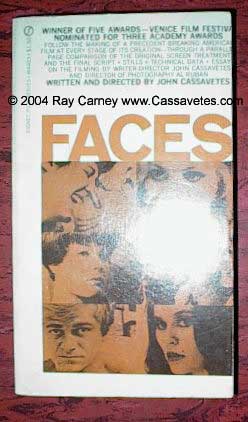 We
can eavesdrop, as it were, on Cassavetes's creative process—watching
his mind at work as he experiments with different ways of telling
his story and with different stylistic effects, like the strange
use of music in the McCarthy scene. Cassavetes's revisions provide
a glimpse into the inner workings of the heart and mind of one
of the most important filmmakers of the past fifty years. It's
no exaggeration to compare this discovery to finding a version
of Citizen Kane with a new beginning and a different shot
selection." We
can eavesdrop, as it were, on Cassavetes's creative process—watching
his mind at work as he experiments with different ways of telling
his story and with different stylistic effects, like the strange
use of music in the McCarthy scene. Cassavetes's revisions provide
a glimpse into the inner workings of the heart and mind of one
of the most important filmmakers of the past fifty years. It's
no exaggeration to compare this discovery to finding a version
of Citizen Kane with a new beginning and a different shot
selection."
In one of those ironic
twists that occasionally take place in the search for lost masterpieces,
some time after his discovery of this new long print of Faces,
Prof. Carney realized that, in all likelihood, he had personally
been responsible for its being in the Library of Congress collection.
The story goes as follows. Several years before his visit to
the Library of Congress, Prof. Carney received a letter from
a company in charge of the liquidation of an old, discontinued
film warehouse. It informed him that rather than simply throwing
out old, unclaimed footage that had been left in storage, the
company was attempting to return the material to whoever they
could locate who might be interested in having it. Since Prof.
Carney was the acknowledged world's expert on John Cassavetes'
work, the company offered Prof. Carney the cans of Cassavetes
material that had been left in the warehouse. In this collection
of material were several cans labeled Faces. The liquidation
company offered Prof. Carney the opportunity to pick up the material
personally or have it shipped to a location of his choice. Since
he did not have storage or preservation facilities, Carney declined
the gift and instructed the company representative to get in
contact with the Motion Picture Division of the Library of Congress.
He told the company that the Library of Congress would be in
a better position to preserve and protect the material than he
was. Of course at that time, Prof. Carney did not realize that
he was turning down and passing along an alternate print of the
film. But based on what he has been able to learn about the acquisition
history of the print he viewed, the print described above, it
appears to have been the very material offered to him, the very
print he was personally responsible for turning over to the Library
of Congress, a few years before. The Gods must have been looking
out for him after that. It was poetic justice that Prof. Carney
would be the one to find the gift he had put in the hands of
the Library.
To read a press account
of the discovery click
here.
For more information
about the making of Faces and the alternate edits, see:
Ray
Carney, Cassavetes on Cassavetes: (Faber and Faber/Farrar, Straus
and Giroux, 2001), pp. 185-190 and 132-145.
To
read a chronological listing of events between 1979 and the present connected
with Ray Carney's search for, discovery of, and presentation of new material
by or about John Cassavetes, including a chronological listing of the
attempts of Gena Rowlands's and Al Ruban's to deny or suppress Prof. Carney's
finds, click
here.
The
opinion of Harmony Korine, writer-director of Kids, Gummo, Julian
Donkey-Boy about Ray Carney's Cassavetes on
Cassavetes:
"THE
BEST FILM BOOK EVER WRITTEN."
|
The
opinion of Xan Cassavetes, John Cassavetes' daughter
and the director of Z Channel and other works,
about Ray Carney's Cassavetes on Cassavetes,
as relayed to Carney by a friend in Los Angeles (stars
indicate omitted personal material):
"I
am still in LA, working on *** , which is coming along.
Real progress. This evening saw Z CHANNEL, a new
documentary by Xan Cassavetes. *** I spoke with her after
the screening. I thought you might like to know that
she absolutely loves CASS ON CASS. Says she sleeps
with it. Says it's enabled her to have conversations
with her father she never had."
|
To find out how to obtain
this book, click
here.
|










